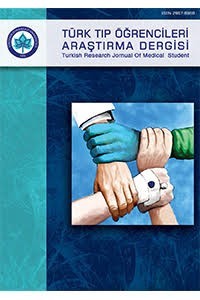Esogü Tıp ve Mühendislik Fak. 2. Sınıf Öğrencilerinin Besin Destekleri ve Bitkisel Ürün Kullanımı Konusundaki Tutumlarının Araştırılması
besin destekleri, tıp öğrencisi
The Research of the Attitudes of Medical and Engineering Second Class Students of ESOGU on the Use of Food Supplements and Herbal Products
engeneering students, Food supplements,
___
- 1. Tek, N.A., Pekcan, G. (2008). Besin destekleri kullanılmalımı?,http://sbu.saglik.gov.tr/Ekutuphane/kitaplar/t65.pdf, Erişim: 28.01.2016.
- 2. De Jong, N., Ocké, M. C., Branderhorst, H. A., & Friele, R. (2003). Demographic andlifestyle characteristics of functional food consume
- 3. Karagözlü C, Bayarer M. (2004). Peyniraltı suyu proteinlerinin fonksiyonel özellikleri ve sağlık üzerine etkileri. Ege Üniversitesi Ziraat Fakültesi Dergisi, 41(2), 197–207.
- 4. Barnes PM, Bloom B, Nahin RL.(2008). Complementary and alternative medicine use among adults and children: United States, 2007. Natl Health Stat Report;12:1-23.
- 5. Koc Z, Avci IA, Saglam Z. (2012). The use of complementary and alternative medicine by older patients that have chronic diseases. HealthMED;6:413-22.
- 6. Aydın S, Bozkaya AO, Mazıcıoğlu M, Gemalmaz A, Özçakır A, Öztürk A. (2008). What influences herbal medicine use? Prevalence and related factors. Turk J Med Sci;38:455-63.
- 7. Algier LA, Hanoglu Z, Ozden G, Kara F. (2005). The use of complementary and alternative (non-conventional) medicine in cancer patients in Turkey. Eur J Oncol Nurs;9:138-46.
- 8. Fox P, Coughlan B, Butler M, Kelleher C.( 2010). Complementary alternative medicine (CAM) use in Ireland: a secondary analysis of SLAN data. Complement Ther Med;18:95-103.
- 9. Robinson A, McGrail MR. (2004). Disclosure of CAM use to medical practitioners: a review of qualitative and quantitative studies. Complement Ther Med;12:90-8.
- 10. Krasuski RA, Michaelis K, Eckart RE. (2006). The cardiovascular patient’s perceptions of complementary and alternative medicine. Clin Cardiol;29:161-4.
- 11. Gücük İpek E, Güray Y, Demirkan B,# Güray U, Kafes H, Başyiğit F. (2013). Kardiyoloji polikliniğine başvuran hastalarda bitkisel kökenli alternatif tedavilerin ve tamamlayıcı besin ürünlerinin tüketim prevalansı. Türk Kardiyol Dern Arş - Arch Turk Soc Cardiol;41(3):218-224
- 12. Yeh GY, Davis RB, Phillips RS. (2006). Use of complementary therapies in patients with cardiovascular disease. Am J Cardiol;98:673-80.
- 13. Ernst E. (2002). The risk-benefit profile of commonly used herbal therapies: Ginkgo, St. John’s Wort, Ginseng, Echinacea, Saw Palmetto, and Kava. Ann Intern Med;136:42-53.
- 14. Eisenberg DM, Kessler RC, Foster C, Norlock FE, Calkins DR, Delbanco TL. (1993). Unconventional medicine in the United States. Prevalence, costs, and patterns of use. N Engl J Med;328:246-52.
- 15. Erden, B. F., Tanyeri, P. (2004). Ülkemizde Vitamin ve Mineral Eklentilerin Akılcı Kullanımı. Sted, 13, 411-414.
- ISSN: 2667-8969
- Başlangıç: 2019
- Yayıncı: Eskişehir Osmangazi Üniversitesi
İlgın Nilhan MANZAK, Celal Anıl UĞURLU, Mehmethan MARAŞLIOĞLU, Serpil ÖZBEY, Mehmet Özgür PINARBAŞLI
Yakup YAVAŞ, Ali Han SEZGİN, Selen BİLGET, Hazal ARAS, Uğur DEMİR, Büşra VAROL, Emre Alp FİTOZ, Burcu DEMİR, Meltem YETER, Havva Esma TAŞKIN, Ahmet MUSMUL, Kevser EROL
Çevre Kirliliğinin İnsan Sağlığı Üzerindeki Etkileri
Jahan İBADULLAYEVA, Klara JUMANİYAZOVA, Sina AZİMZADEH, Selim CANIGÜR, Ferhan ESEN
Eskişehir Bölgesinde Doğrulanmış Gerçek HIV Pozitiflik Görülme Oranı
İbrahim Fadıl DOĞANER, Furkan Ahmet TABAK, Tercan US
Engin ÖZAKIN, Berkay ALPER, Gamzenur ÇİFTÇİ, Berkay DALMIŞ
Orbita Üzerine Morfometrik Bir Çalışma
Kübra ÖNAT, Elif GÖKSU, Mustafa Enes KURT, Melek KARACHOUS, Abdullah ORTADEVECİ, Hilmi ÖZDEN
